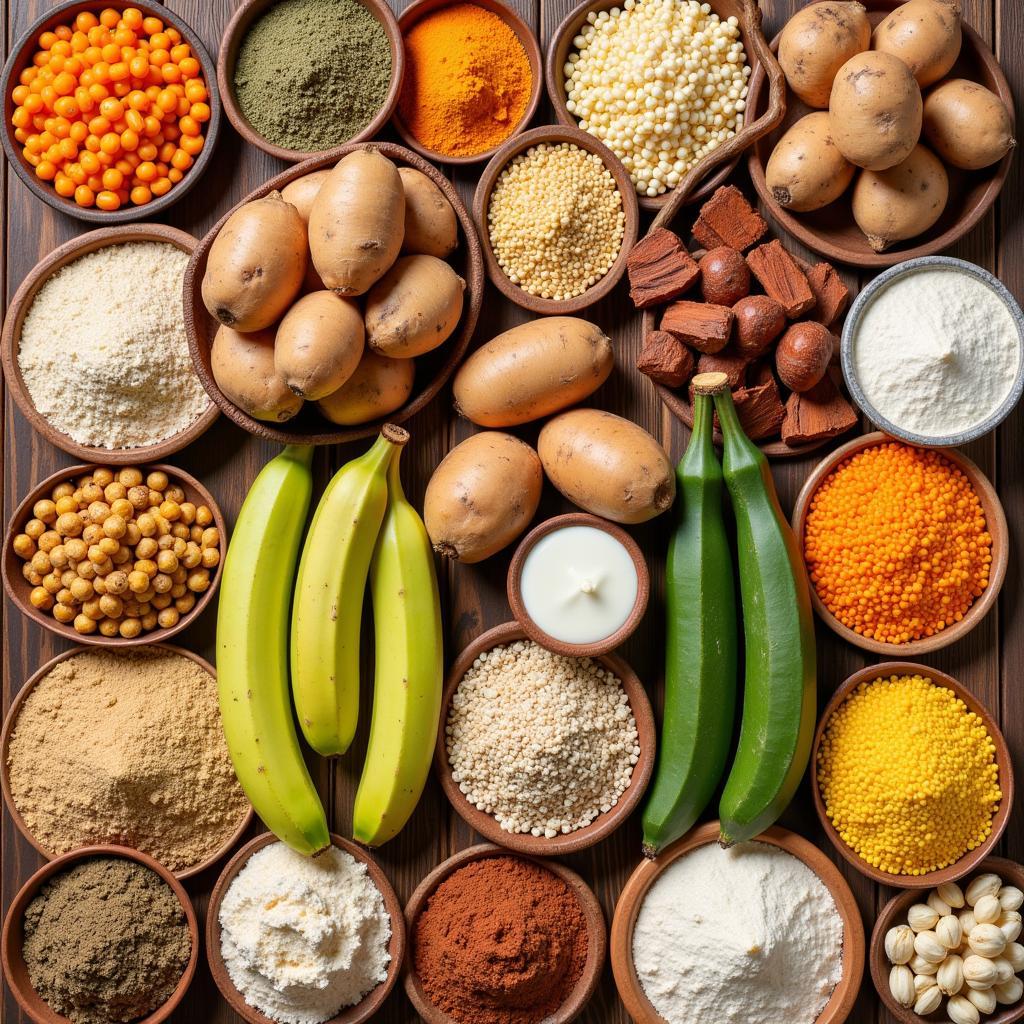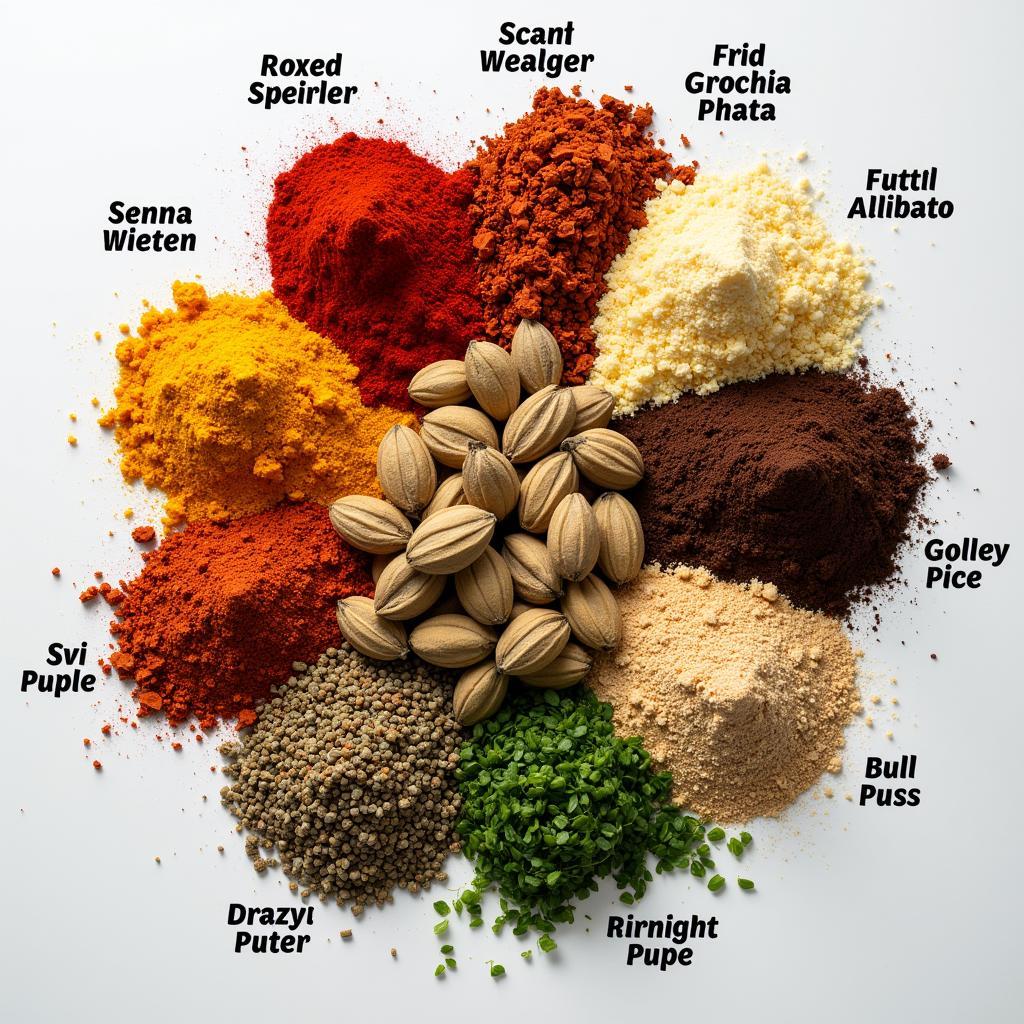African Food Items Chart: Exploring the Continent’s Diverse Culinary Delights
African food is as diverse as the continent itself, bursting with vibrant flavors, unique ingredients, and time-honored traditions. From the spicy stews of West Africa to the fragrant tagines of North Africa, and the rich, meaty dishes of Southern Africa, each region boasts a distinct culinary identity. This African Food Items Chart will take you on a journey to explore the continent’s most popular dishes, highlighting the diversity and deliciousness of African cuisine.
Staple Foods: The Foundation of African Cuisine
Many traditional African dishes rely on a foundation of staple foods, often grains or starches, forming the base of countless meals. These staples vary across regions, reflecting local climate and agricultural practices.
- West Africa: Dominated by root crops like cassava (yucca) and yams, along with grains like millet, sorghum, and fonio. Fufu, a dough-like accompaniment made from boiled and pounded starchy vegetables, is a West African staple.
- East Africa: Maize (corn) reigns supreme, often ground into flour for ugali (a stiff porridge) or used in various other dishes. Other staples include rice, plantains, and potatoes.
- North Africa: Wheat takes center stage, transformed into couscous, bread, and pastries. This region also enjoys a variety of legumes, including chickpeas, lentils, and beans.
- Southern Africa: Maize is prominent, often enjoyed as pap (a porridge similar to polenta) or used to make bread and beer. Root vegetables like sweet potatoes and cassava are also common.
 African Staple Foods
African Staple Foods
Meats and Proteins: From Savory Stews to Grilled Delights
Meat often plays a starring role in African cuisine, prepared in a myriad of ways. From slow-cooked stews to grilled skewers, the continent offers a diverse range of meat-based dishes.
- West Africa: Peanut-based stews featuring chicken, beef, or goat are common, often served with rice or fufu. Grilled fish, seasoned with spices and herbs, is another popular choice.
- East Africa: Nyama choma, meaning “grilled meat” in Swahili, is a beloved dish, typically featuring goat, beef, or chicken grilled over an open flame.
- North Africa: Tagines, slow-cooked stews prepared in clay pots, often feature lamb, chicken, or beef, simmered with vegetables, spices, and dried fruits.
- Southern Africa: Braai, a South African barbecue tradition, celebrates grilled meats, including boerewors (farmer’s sausage), steak, and chicken. Biltong, dried cured meat, is a popular snack.
Vegetables and Legumes: Adding Vibrancy and Flavor
Vegetables and legumes provide a colorful and nutritious counterpoint to the rich flavors of African cuisine. They are incorporated into stews, soups, side dishes, and salads, adding texture, flavor, and essential nutrients.
- West Africa: Leafy greens, like spinach and amaranth, are widely consumed, often cooked with tomatoes, onions, and chilies. Okra, a popular vegetable, features in soups and stews.
- East Africa: Sukuma wiki, a simple dish of sautéed greens (often collard greens or kale) is a common side. Githeri, a hearty stew of maize and beans, is a staple in Kenya.
- North Africa: Salads, often featuring fresh tomatoes, cucumbers, onions, and olives, are a refreshing accompaniment to heavier meals. Legumes, like chickpeas and lentils, are used in soups, stews, and salads.
- Southern Africa: Chakalaka, a spicy relish made with tomatoes, onions, peppers, and often beans, adds a flavorful kick to many dishes. Morogo, a type of wild spinach, is a traditional green.
Flavors and Spices: A Sensory Journey for Your Palate
African cuisine is renowned for its bold and complex flavors, often achieved through a skillful blend of herbs and spices.
- West Africa: Known for its use of scotch bonnet peppers, ginger, garlic, and a spice blend called suya, which typically includes peanuts, ginger, paprika, and cayenne pepper.
- East Africa: Characterized by the use of cumin, coriander, turmeric, and cardamom. Pili pili, a Swahili term for chili peppers, is used to add heat.
- North Africa: Famous for its fragrant spice blends like ras el hanout, a complex mix that can include cardamom, cumin, clove, cinnamon, nutmeg, mace, allspice, coriander, chili peppers, and turmeric. Harissa, a fiery chili paste, adds a kick to many dishes.
- Southern Africa: Peri-peri, a hot chili pepper, is a defining ingredient in many dishes. Other common spices include coriander, cumin, turmeric, and ginger.
 African Spices and Herbs
African Spices and Herbs
Conclusion: Exploring the Rich Tapestry of African Cuisine
This African food items chart is just a glimpse into the diverse and delicious world of African cuisine. Each region offers a unique culinary experience, shaped by geography, history, and cultural traditions. By exploring the continent’s diverse flavors and ingredients, you’ll embark on a culinary adventure that will tantalize your taste buds and broaden your culinary horizons.
FAQs:
1. What is the most popular food in Africa?
It’s impossible to pick just one! Africa’s culinary landscape is incredibly diverse. However, some widely enjoyed dishes include Jollof Rice (West Africa), Nyama Choma (East Africa), Tagine (North Africa), and Braai (Southern Africa).
2. What makes African food so unique?
African cuisine is unique for its bold flavors, creative use of spices, and reliance on fresh, locally sourced ingredients. The continent’s diverse cultures and culinary traditions result in an incredibly rich and varied culinary landscape.
3. Is all African food spicy?
While some African dishes are known for their spiciness, not all African food is hot. The level of heat varies greatly depending on the region and specific dish. Many dishes rely on a balance of flavors, with spiciness just one element of the overall taste profile.
4. Where can I find authentic African food?
You can find authentic African restaurants in many major cities around the world. Look for restaurants specializing in specific regional cuisines for a truly immersive experience.
5. What are some good resources for African recipes?
Numerous websites and cookbooks are dedicated to African cuisine. Explore online recipe databases or search for cookbooks specializing in the region you’re interested in.
Need Help? Contact Us!
For assistance with your African culinary journey, reach out to our team!
- Phone: +255768904061
- Email: kaka.mag@gmail.com
- Address: Mbarali DC Mawindi, Kangaga, Tanzania.
Our dedicated customer service team is available 24/7 to help you.

